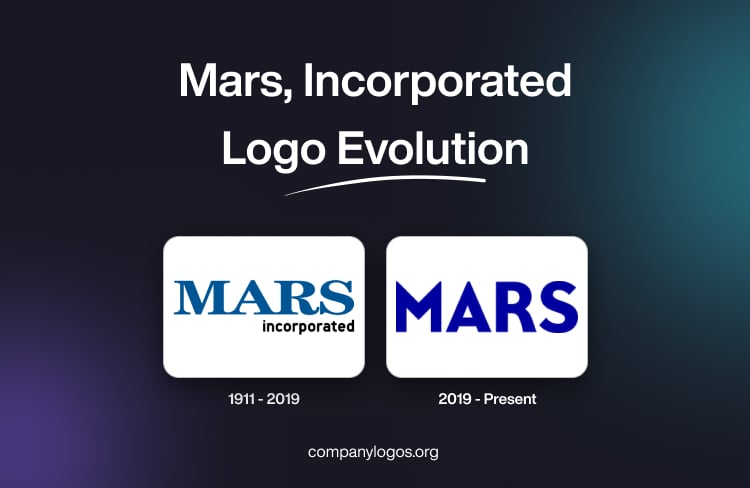
Mars, Incorporated is a global leader in confectionery, pet care, and food products. Over the decades, the visual identity of this US-based company has undergone several changes, which reflect shifts in design trends, consumer preferences, and corporate strategy. This article delves into the history and evolution of the Mars logo over the years.
The Genesis of the Mars, Incorporated Logo (1911 – 2019)
The original Mars, Incorporated logo featured the wordmark in a custom sans-serif typeface where the bottom ends of the letters were connected to each other. Besides, the serifs of individual letters were pointed. The logo showed the “Mars” wordmark in bold, uppercase, while the wordmark “Incorporated” in lowercase was displayed in black and in a smaller size.

(2019 – Present)
The 2019 logo variant in deep blue colour was designed by Jones Knowles Ritchie, and it featured the wordmark “Mars” in bold uppercase using a custom rounded typeface. The logo also featured a monogram comprising the letter “M” in a blue and green colour combination.


The Elements of the Mars, Incorporated Logo
Font
The Mars, Incorporated logo uses a bold, clear, modern, and custom sans-serif typeface. The choice emphasises professionalism and a no-nonsense, purpose-driven philosophy.
Colour
The Mars, Incorporated logo uses a deep blue colour to represent trust, legacy, and reliability.
The History of Mars, Incorporated
Mars, Incorporated is one of the world’s largest privately held companies, which is renowned for its iconic brands across the confectionery, pet care, and food industry segments. Founded over a century ago, Mars has evolved from a small candy business into a diversified global powerhouse. It was founded by Frank C. Mars in Tacoma, Washington, in 1911, where he and his wife, Ethel, started making and selling candy from their kitchen. This humble operation laid the groundwork for what would become a confectionery empire.
In the 1920s, the couple’s son, Forrest Mars Sr, joined the business. Frank and Forrest had a strained relationship, but Forrest brought sharp business acumen and ambition. In 1923, Mars launched the Milky Way bar, which became the first mass-marketed filled chocolate bar in the U.S. It was inspired by malted milkshakes and proved wildly popular. It quickly propelled the company to national prominence.
In 1932,Forrest Mars left the U.S. to start his own business in Slough, England. There, he created the Mars bar, a slightly different formulation from the Milky Way, and later launched Maltesers. During the Second World War, Forrest returned to the U.S. and, in partnership with Bruce Murrie (son of Hershey executive William Murrie), launched M&M’s®. These candy-coated chocolates were developed to withstand warm climates and were initially sold exclusively to the military. They became a public sensation after the war.
Mars began diversifying beyond candy. In 1968, it acquired Kal Kan Foods, which marked its entry into pet food. This was an important move that laid the foundation for Mars Petcare, which is now one of the company’s largest divisions. The company also acquired Uncle Ben’s (now Ben’s Original) rice brand and entered into the human food sector.
During the seventies and eighties, Mars continued to expand globally and invest in R&D. It launched new brands, improved production efficiencies, and entered new markets. The company also maintained a strict policy of secrecy and private ownership, which continues to this day. Mars expanded its pet care portfolio by acquiring several major brands, which include Pedigree, Whiskas, and Royal Canin. It also invested in veterinary care by purchasing Banfield Pet Hospital and, later, VCA and AniCura.
In 2008, Mars, Incorporated purchased the Wm. Wrigley Jr. Company, the chewing gum giant known for Juicy Fruit, Orbit, and Doublemint. This move created one of the world’s biggest confectionery conglomerates. As of the 2020s, Mars employs over 140,000 associates in more than 80 countries and generates more than $45 billion in annual revenue. Despite its size, Mars remains entirely family-owned, with a strong emphasis on long-term thinking and values-based leadership.
Its business is now organised into five main segments:
- Mars Wrigley (Confectionery)
- Mars, Incorporated Petcare
- Mars, Incorporated Food & Nutrition
- Mars, Incorporated Edge (focused on nutrition and health science)
- Mars, Incorporated Veterinary Health
The story of Mars, Incorporated, is one of entrepreneurship, innovation, and evolution. What began as a small candy kitchen in 1911 and then transformed into a global leader in multiple industries. The company has demonstrated a remarkable ability to adapt, diversify, and lead.
Interesting Facts About Mars, Incorporated
- Mars, Incorporated was founded in 1911 by Frank C. Mars in Tacoma, Washington. It began as a small candy business making buttercream candies at home.
- After initial setbacks, Frank Mars relocated to Minneapolis in 1920, where the company started producing iconic products like Snickers and Milky Way bars, which became best-sellers.
- Forrest E. Mars Sr, Frank’s son, played a crucial role in expanding the business internationally. He moved to the UK in the 1930s and started Mars Limited. He thus laid the foundation for the global presence of the company.
- Mars, Incorporated entered the pet care market in 1935 by acquiring Chappie, which is a UK-based dog food company. Today, pet care is a major business segment for the company alongside confectionery and food products.
- Mars, Incorporated is behind some of the world’s most famous confectionery brands. These include M&M’s, Snickers, Milky Way, 3 Musketeers, Maltesers, and Doublemint gum.
- Mars, Incorporated was an early adopter of tying products to media. In 1940, it sponsored a radio quiz show called Dr IQ. It also created enduring ad campaigns like the Doublemint Twins in 1939.
- Mars, Incorporated remains a privately held company owned entirely by the Mars family. This is indeed rare for a company of its size and global reach.
- As of 2024, Mars, Incorporated employs around 150,000 people worldwide and generates approximately $50 billion in annual revenue. These make it one of the largest food companies globally.
- Forrest Mars Sr. introduced a unique company culture in the 1960s where all employees were called associates, everyone punched a time clock, and offices were arranged to encourage communication and equality.
- Mars, Incorporated established the Waltham Centre for Pet Nutrition in the UK, which is a leading authority on pet care and nutrition. This reflects the company’s investment in science-based product development.
- In 1967, the separate Mars businesses owned by Frank and Forrest merged, uniting the company’s operations and accelerating growth.
- Mars, Incorporated holds a significant share of the global chocolate confectionery market, with brands like Maltesers and Galaxy leading in regions like the UK.
Finally
The Mars, Incorporated logo shows the growth and adaptation of the company for more than a century. The story of its logo had humble beginnings with a simple wordmark, which has now evolved into its current dynamic and digitally optimised design. The Mars, Incorporated logo has continually transformed to reflect contemporary aesthetics and corporate values. These changes underscore the dedication of Mars, Incorporated, to innovation, consumer engagement, and a unified brand identity across its global operations.